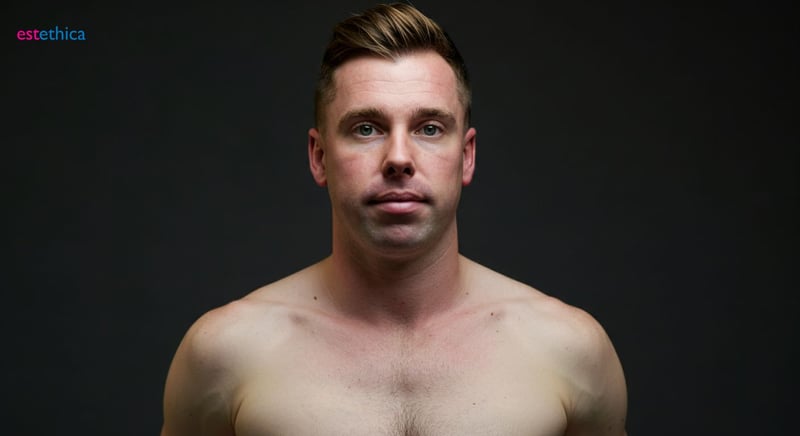Gynecomastia: Unmasking the Myths of 'Man Boobs'
Understanding gynecomastia is the first step to regaining self-assurance and achieving a sculpted masculine physique.
Exploring the topic of gynecomastia, often colloquially referred to as 'man boobs', is crucial for understanding its implications for many men globally. This condition, characterized by enlarged male breast tissue, can impact men of all ages, leading to psychological and physical discomfort. Our comprehensive guide will delve into the causes, treatments, and methods to regain confidence and a flatter chest.
Decoding Gynecomastia: What It Is and Isn't
Differentiating Gynecomastia: Beyond Surface Appearances
Gynecomastia is often mistaken for simple chest fat, but it’s distinctly different. It involves the actual growth of glandular tissue in the male breast, not just the accumulation of adipose tissue. This condition is typically triggered by hormonal imbalances, often between estrogen and testosterone.
- Glandular Tissue Growth: Unlike fat, gynecomastia features a palpable mass under the nipple area.
- Hormonal Influence: This condition is frequently linked to hormonal shifts, which stimulate breast tissue development.
- Treatment Differences: Effective management often requires addressing the hormonal imbalance, rather than just fat reduction strategies.
Understanding these differences is crucial for identifying the true nature of enlarged male breasts and seeking the right treatment. Men experiencing this should consult with specialists who have handled numerous cases, like those at estethica Global, to get accurate diagnoses and effective solutions.
Navigating Gynecomastia Treatments
When considering treatment options, approaches vary based on the severity and cause of the gynecomastia. Lifestyle changes, such as diet and exercise, might help reduce overall body fat but won't eliminate the glandular tissue of gynecomastia. Gynecomastia can be addressed through surgical methods, like liposuction or excision, to remove excess fat and glandular tissue.
- Consultation: Begin with a detailed evaluation to determine the underlying cause and extent of glandular growth.
- Treatment Selection: Choose the appropriate method, whether minimally invasive techniques or surgical removal, based on medical advice.
- Post-operative Care: Follow prescribed care, including compression garments, to optimize healing and results.
Early diagnosis and proper treatment planning can enhance outcomes, reducing the psychological impact of having enlarged male breasts. For many, seeking professional help from a clinic specializing in male breast reduction is a proactive step toward improving both physical appearance and self-confidence.

Beyond Chest Fat: Exploring the Root Causes of Enlarged Male Breasts
The Role of Hormones in Gynecomastia Development
Hormonal imbalances, particularly elevated estrogen levels, are often the primary drivers behind the development of gynecomastia. These imbalances stimulate the growth of glandular tissue in the breast area. Conditions such as hyperthyroidism and chronic liver disease can disrupt the normal hormonal balance and contribute to the onset of gynecomastia. Identifying the specific cause through a comprehensive medical evaluation is crucial for effective treatment. Furthermore, certain medications are known to affect hormone levels, escalating the risk of developing enlarged male breasts.
- Medications: Anabolic steroids, anti-androgens, and some AIDS medications can lead to hormonal imbalances.
- Health Conditions: Liver and kidney diseases can impair hormone metabolism, affecting breast tissue.
- Natural Imbalances: Hormonal shifts during puberty or aging can sometimes result in gynecomastia.
Understanding these varied causes is essential for tailoring effective treatment strategies. At estethica Global, our specialists conduct thorough evaluations to ensure targeted and successful outcomes. Early detection and intervention can significantly improve the quality of life for individuals affected by this condition.
The Significance of Medical Evaluation
A thorough medical evaluation is essential to pinpoint the exact cause of gynecomastia and rule out other potential health issues. Such evaluations typically involve blood tests to assess hormone levels and liver function, alongside physical examinations to assess the breast tissue. In some instances, imaging studies like mammograms may be necessary to differentiate between glandular tissue and fat. Correct diagnosis ensures that the treatment strategy aligns with the underlying cause of enlarged male breasts, enhancing the possibility of a successful outcome. For instance, if medication is causing the issue, altering the prescription may resolve the problem.
- Hormone Level Assessment: Checks for imbalances that could trigger glandular growth.
- Physical Examination: Helps differentiate gynecomastia from pseudogynecomastia (fat accumulation).
- Medical History Review: Identifies potential contributing factors such as medications or health conditions.
Appropriate evaluation and diagnosis can lead to more effective management and reduce the physical and psychological distress associated with this condition. estethica Global prioritizes detailed diagnostic processes to deliver personalized and effective treatment plans for each patient.

Gynecomastia Surgery: Reshaping Confidence with Male Breast Reduction
Surgical Options for Correcting Gynecomastia
Surgical intervention offers a direct approach to reshaping the chest of men affected by gynecomastia. The procedures often involve the removal of excess glandular tissue and fat through methods like liposuction or direct excision. Liposuction is particularly effective for removing excess fat, while excision is used when there is a need to remove glandular tissue or excess skin. A combination of both techniques may be used to achieve the best contour and aesthetic outcome for a patient.
- Liposuction: Suction removes excess fat, contouring the chest.
- Excision: Surgically removes glandular tissue and excess skin.
- Combination: Integrates both techniques for comprehensive reshaping.
Choosing the right surgical option depends on the patient’s specific anatomical characteristics and the surgeon’s expertise. Consulting with skilled professionals ensures tailored treatment plans that align with individual needs and desired outcomes. At estethica Global, experienced surgeons collaborate to determine the most effective surgical strategy for each patient, emphasizing natural-looking results and patient satisfaction. The goal is to provide a flatter, more masculine chest contour that enhances self-esteem.
Achieving Desired Results And Post-Operative Expectations
The key to successful gynecomastia surgery lies in achieving the patient’s aesthetic goals while ensuring a smooth recovery process. Outcomes often depend on the precision of the surgical technique and careful attention to post-operative care. Patients can expect some swelling and bruising immediately following the surgery, which typically subsides within a few weeks. Wearing a compression garment is often recommended to support the healing process, minimize swelling, and help the skin adapt to the new chest contour.
- Compression Garments: Reduce swelling and support skin retraction.
- Limited Activity: Avoid strenuous activities to promote healing.
- Follow-Up Visits: Ensure proper recovery and address any concerns.
Adhering to the surgeon's guidelines regarding activity levels and wound care is crucial for optimal recovery and long-term results. With male breast reduction surgery from estethica Global, patients can see a significant improvement in their chest contour, boosting their confidence and comfort in their appearance. The experienced team is dedicated to providing comprehensive care throughout the surgical journey., thus contributing to a more confident self-image.

Navigating Gynecomastia: Expert Insights for a Flatter Chest
Lifestyle Adjustments and Medical Consultations for Gynecomastia
Lifestyle changes, such as adopting a balanced diet and incorporating targeted exercises, can play a supportive role in managing the appearance of gynecomastia. For instance, focusing on exercises that build pectoral muscle can help improve chest definition, although it won't eliminate glandular tissue. Dietary adjustments aimed at reducing estrogen levels and promoting healthy testosterone production may also contribute to a more favorable hormonal balance. Consulting with healthcare professionals is crucial not only for surgical options but also to explore alternative medical treatments and therapies that can reduce the effects of gynecomastia.
- Balanced Diet: Foods that support balanced hormone levels can aid in managing gynecomastia.
- Targeted Exercises: Strength training can enhance muscle tone, improving chest appearance.
- Medical Therapies: Can provide alternatives to surgical interventions.
Seeking guidance helps individuals make informed decisions about their health and self-esteem. By combining lifestyle modifications with professional medical advice from clinics like estethica Global, men can effectively address the physical and psychological aspects of gynecomastia, leading to improved overall well-being.
Exploring Treatment Paths and Managing Expectations
When dealing with gynecomastia, understanding the range of available treatments and setting realistic expectations are key components of a successful journey. Medical interventions can range from hormone therapy to surgical procedures, depending on the underlying cause and the severity. For individuals considering surgery, it is important to have thorough discussions with surgeons to understand potential outcomes and recovery processes. Consulting with healthcare professionals can help clarify which treatment approaches align best with individual circumstances and health goals. It's worth noting that lifestyle adjustments like diet and exercise may complement medical or surgical treatments but are unlikely to resolve the condition on their own if significant glandular tissue is present.
- Hormone Therapy Evaluation: Assesses suitability and potential effectiveness.
- Surgical Consultations: Provides detailed insight into procedural options.
- Realistic Expectation Setting: Ensures alignment between desires and possible results.
Navigating these options requires informed decision-making and emotional support. By engaging with medical experts at facilities such as estethica Global, patients are better able to approach this journey with understanding and be prepared for what to expect during and after treatment, including follow-up care and potential lifestyle adjustments for maintaining long-term results.
Liposuction Combined with Glandular Excision for Optimal Chest Contouring in Gynecomastia
Comprehensive Post-Operative Support and Care Ensure Optimal Recovery Following Gynecomastia Surgery
Frequently Asked Questions
What exactly is gynecomastia, and how is it different from just having chest fat or "man boobs"?
What are the primary root causes of enlarged male breasts or gynecomastia?
What surgical options are available for correcting gynecomastia and achieving a flatter chest?
What can I expect during the gynecomastia recovery period after male breast reduction surgery?
Can lifestyle adjustments help reduce male breast size naturally with gynecomastia?
Achieve your aesthetic goals with estethica's personalized treatment plans and world-class expertise.
📞 Discuss Your Options Today!